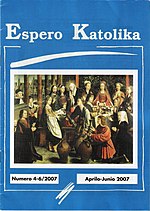Espero Katolika
| Espero Katolika | |
|---|---|
| description | Association magazine of the International Catholic Esperanto Association |
| Area of Expertise | Roman Catholic Church |
| language | Esperanto |
| First edition | 1903 |
| Frequency of publication | bi-monthly |
| editor | International Catholic Esperanto Association |
| Web link | (esperanto) www.ikue.org/ek.html (esperanto) |
| ZDB | 216455-3 |
Espero Katolika (Esperanto: Catholic Hope ) is the association magazine of the International Catholic Esperanto Association (IKUE) . The publication was already published before the founding of the IKUE by the French clergyman and association founder, Emile Peltier, since 1903. Today Espero Katolika is the oldest continuously published magazine in Esperanto .
history
Originally, Peltier tried to found an association of Catholic Esperanto speakers called "Espero Katolika". This project failed because the number of members fell short of the requirements of French law. As a result, Peltier decided to instead publish a magazine that should act as a link between Catholic Esperanto speakers. The first edition was published in October 1903; In 1904 the edition reached a modest 300 pieces. In 1909 Peltier died at the age of 38. His work was continued with the establishment of the IKUE at the Esperanto Congress in Paris in 1910 and the takeover of Espero Katolika as an association magazine. The magazine was published monthly from then on. In addition, their distribution was no longer limited to France, but also extended to other countries. The construction work was interrupted by the outbreak of the First World War, in the course of which important employees were drafted so that the magazine could no longer appear. It was not until 1920 that publication was resumed.
In 1936 Heinrich Himmler forced the dissolution of the German Esperanto Society, which at the same time banned the magazine in Germany. At the beginning of the Second World War, the editor of Espero Katolika was based in the Netherlands. The war meant that only a very small readership could be reached; In 1940 the magazine was discontinued.
After the end of the war, the Esperanto speakers in the West were able to reorganize and from 1946 Espero Katolika was published again. In Eastern Europe the organization was more difficult. In the former GDR, for example, all attempts at organization by Esperanto speakers were prohibited until 1965. On the other hand, Espero Katolika was available again in Poland from 1957.
In 2000 the headquarters of the IKUE were relocated to Rome and since then the editor of the Espero Katolika has also worked there. The magazine is also printed there and appears every two months with worldwide news from the Catholic Church , information about papal activities, beatifications and other content.
Web link
Individual evidence
- ↑ a b c d e f g h i j k l m Ulrich Matthias (2002) Esperanto - The New Latin for the Church and for Ecumenism ; Flandra Esperanto-Ligo, Antwerp; ISBN 9077066047
- ↑ Ulrich Matthias ( Memento from June 29, 2007 in the Internet Archive ) (2002) Biographical-Bibliographical Church Lexicon ; Publishing house Traugott Bautz
- ↑ Self-presentation of IKUE on the Internet ( German ; PDF; 110 kB), accessed on October 2, 2012
